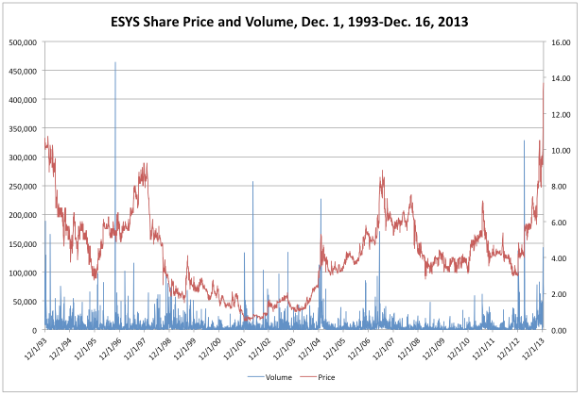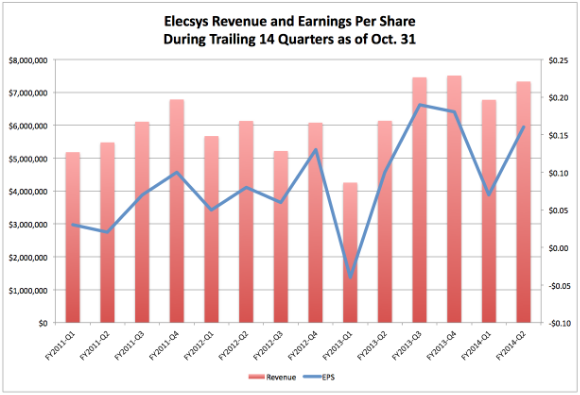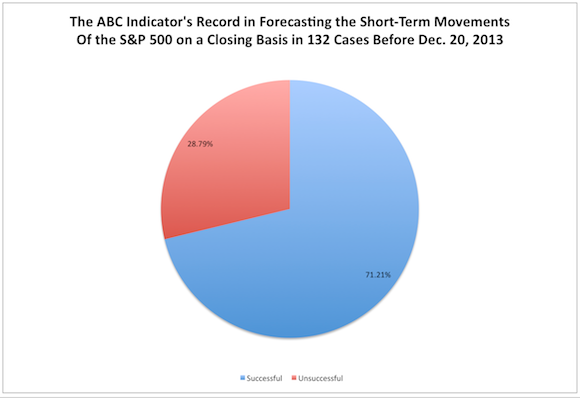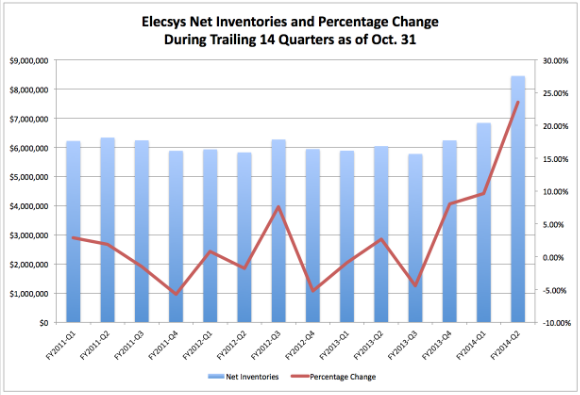Sooner or later, the Elecsys
Corp. (ESYS)
will come to the end of the parabolic move in its share price that began after
the company reported before the equity-market open Dec. 9 the excellent financial
results for its 2014 fiscal year’s second quarter, which concluded Oct. 31.
Animal spirits in the stock market subsequently drove the electronic-equipment
firm’s closing share price fast and furiously to an all-time high of $13.70 on
Dec. 16 from $9.54 on Dec. 6, a gain of $4.16, or 43.61 percent.
Based on the fundamental valuation of ESYS, one could
anticipate the culmination of its parabolic move this week. But Elecsys is a
micro-capitalization company, with the 3,806,968 shares outstanding giving it a
current market cap of about $50.37 million, based on the share count in the
U.S. Securities and Exchange Commission Form
10-Q the firm filed the same day it delivered its quarterly financial
report. Decembers being Decembers and micro-caps being micro-caps, it is
therefore conceivable the stock could run higher and longer than otherwise would
be the case.
Such an additional run may not be backed by the fundamental
valuation of Elecsys, but it might be supported by the nature of the company’s
ownership. Insiders hold about 33.07 percent of the shares, while institutions
hold about 4.26 percent of them, according to Nasdaq.com.
Meanwhile, ESYS short interest was negligible Nov. 29, with just 2,483 shares
held short then, the same
source reported. Of course, this figure most likely will rise in December,
especially given the fact ESYS is not an optionable stock.

Source: This chart is
based on ESYS share-price and -volume data at Yahoo! Finance.
The Business of
Elecsys
Elecsys offers so-called machine-to-machine (M2M)
communication-technology solutions, data-acquisition and -management systems,
and electronic equipment for industrial applications on a global basis. Based
in Olathe, Kan., the company has described its primary markets as being in
agriculture, energy production and distribution, safety and security systems, transportation,
and water management. In serving those markets, the firm furnishes wireless remote
monitoring, mobile computing, industrial data communication, and custom electronic-manufacturing
services encompassing assemblies and displays.
Color on one of Elecsys’ lines of business was provided in its
Aug. 1 announcement
of a $1.25 million order placed by the Al Rushaid Group to supply remote
monitoring equipment for deployment in the Ghawar oil field of Saudi Arabia.
The company reported its equipment would enable remote monitoring of
cathodic-protection-system performance at about 600 seawater injection wells in
the mammoth oil field, commonly described as the largest conventional oil field
in the world. The firm’s equipment would be installed as part of a project to
employ smart oil-field technologies to extract resources more efficiently and maximize
production.
In its latest SEC Form 10-Q, Elecsys reported the revenue
and gross margin for each of two business segments: proprietary M2M products
and services on the one hand and original equipment manufacturer (OEM) custom
solutions on the other hand.
During Q2, the company’s revenue for proprietary M2M
products and services advanced to $3,742,000 this fiscal year from $3,148,000
last fiscal year, an increase of $594,000, or 18.87 percent. The gross margin
for this segment was 51.74 percent, compared with a reported 53.00 percent in
the same quarter a year ago.
Over the same period, the firm’s revenue for OEM custom
solutions climbed to $3,588,000 from $2,990,000, an increase of $598,000, or
20.00 percent. The gross margin for this segment was 30.43 percent, compared
with a reported 24.80 percent in the same quarter a year ago.
Elecsys reported its overall Q2 revenue rose to $7,330,000
this fiscal year from $6,138,000 last fiscal year, an increase of $1,192,000,
or 19.42 percent. On the same basis, the company said its earnings per share
surged to 17 cents from 11 cents, an increase of 6 cents, or 54.55 percent. The
firm’s overall gross margin was 41.31 percent, compared with a reported 39.30
percent in the same quarter a year ago.
Elecsys has been profitable for five consecutive quarters
and for three straight fiscal years, as illustrated by the below chart. The
company most likely will be profitable again this fiscal year, with EPS of 23
cents already booked in the first half and the firm saying in its most recent Form
10-Q, “Although the current period did not contain revenue from the previously
announced order from the Al Rushaid Group in Saudi Arabia, due to a delay by
the prime contractor, we expect a positive impact on revenues from this order
over the next two fiscal quarters.”

Source: This chart is based
on figures in Elecsys’ relevant SEC
filings.
The Valuation of
Elecsys
If I had to employ one single solitary word to describe the
spark that set ESYS ablaze at the outset of the stock’s parabolic move last
week, then it would have to be Backlog.
In the incendiary context of the Elecsys Q2 financial report, its EPS was the
fuel, and its revenue was the kindling, but its backlog was the tinder.
The Q2 backlog scheduled for delivery during the ensuing 12
months advanced to $12,423,000 this fiscal year from $10,638,000 last fiscal
year, an increase of $1,785,000, or 16.78 percent. To put this backlog in
perspective, it helps to know the company’s overall revenue in the 2014 fiscal
year’s first half was $14,104,000. By segment, the Q2 backlogs were $10,332,000
for OEM custom solutions and $2,091,000 for proprietary M2M products and
services.
As ESYS’ recent share-price action has shown, equity-market
participants really and truly value this kind of visibility.
OK, the Elecsys Q2 backlog and income statement appeared flat-out
great, but neither its cash-flow statement nor its balance sheet seemed so. One
reason is the explosive growth in the company’s net inventories, which soared
to $8,447,000 in Q2 from $6,837,000 in Q1, an increase of $1,610,000, or 23.55
percent, as illustrated by the below chart.
Historically, I believe, rising inventories (or supply) have
been either a coincident or a leading indicator of unexpectedly falling revenue
(or demand), and falling inventories have been either a coincident or a leading
indicator of unexpectedly rising revenue. In this case, however, I think
Elecsys’ bloated net inventories mostly reflect the company’s readiness to
deliver on its backlog in general and the Al Rushaid Group order in particular.
Because the firm is a micro-cap, there is no analyst coverage to use as a
reality check in this circumstance.
Elecsys’ net inventories are one thing; its indebtedness is
another. In my analysis of the company’s balance sheet at the close of Q2, I
began with $501,000 in cash and cash equivalents, subtracted $7,058,000 in
total liabilities, and divided by 3,806,968 shares to produce net cash per
share of -$1.72. It is true the firm’s latest SEC Form 10-Q has reported $1,842,000
of its liabilities will not have to be paid until after 2018, and it is true its
current ratio is 3.22, but it is equally true I do not like any figure on net
cash per share to begin with a minus sign.
Given ESYS’ parabolic move, it is unsurprising the stock
appears either fully valued or overvalued in an MSN
Money comparison of four key price ratios centered on it and the
contract-manufacturers industry averages, as well as in a comparison with my
own estimate. Before the stock-market open Tuesday, Elecsys looked more expensive than
the industry average by their respective price-to-book value ratios, 3.60
versus 1.53; price-to-cash flow ratios, 42.92 versus 4.81; price-to-earnings
ratios, 22.83 versus 20.53; and price-to-sales ratios, 1.84 versus 0.26. Of
course, the company has better-than-average gross, pretax, and net profit
margins, which account for a piece of its premium price.
Source: This chart is based
on figures in Elecsys’ relevant SEC
filings.
Elecsys and the
Incredible Shrinking Share Count
The number of ESYS shares outstanding is already low, but Elecsys
has a stock-buyback
program in place that could drive this number even lower. According to the
company announcement of the program exactly one year ago, its directors OK’d
the repurchase of as much as 10 percent of the firm’s shares, or 400,000
shares. Providing for the buyback of stock from time to time at prevailing
market prices through either open-market or privately negotiated transactions,
the program has no expiration date.
Based on an analysis of the relevant SEC forms filed between
then and now, I believe Elecsys repurchased 130,774 shares at an average price
of $5.87 and a total cost of about $767,464.50 under the program as of Oct. 31.
Given the company’s debt load and equity structure, certain growth-and-value
investors may wonder whether this approach has resulted in the best allocation
of capital during the past year. This wonderment aside, the firm’s Q2
repurchases of 55,093 shares at an average price of $7.14 and a total cost of about
$393,000 may point to a target it would be willing to defend once the ESYS
parabolic move is over.
Regardless of its share count, the micro-cap Elecsys has to effectively
face different competitors in its different lines of business, as noted in the SEC
Form
10-K it filed July 10. Among these mostly large-cap rivals are Honeywell
International Inc. (HON)
and Motorola Solutions Inc. (MSI)
in the area of mobile computing; the Cooper Industries unit of Eaton Corp. PLC
(ETN),
the Emerson Electric Co. (EMR),
and Siemens AG (SI)
in the area of industrial data communication; and Celestica Inc. (CLS),
Flextronics International Ltd. (FLEX),
and the Sanmina Corp. (SANM)
in the area of electronic-manufacturing services.
The company also has to avoid the concentration of risk represented
by a comparatively small customer base, as pointed out in its Form 10-K. The
firm’s five biggest customers accounted for 53 percent of revenue in the 2013
fiscal year and 43 percent of it in the 2012 fiscal year. During the same two
periods, its largest customer accounted for 30 percent and 20 percent of
revenue, respectively.
Many risks associated with Elecsys as either an investment
or a trading vehicle are well described on pages 11-15 of the company’s Form
10-K. One risk unmentioned there centers on ESYS’ status as a micro-cap stock:
Almost by definition, this means the equity’s points of entry and exit are
similar in size (i.e., it may difficult to get in at a reasonable price and it
may difficult to get out at a reasonable price). A few risks associated with
anything as either an investment or a trading vehicle include changes in the loose-money
policies of the U.S.
Federal Reserve and other central banks around the world. Along this line,
it is important to note the Federal Open Market Committee will conduct its first
meeting of next year on Jan. 28-29.
A hat tip and thanks
to Seeking Alpha commenter Hal44, who mentioned ESYS last week (before the
stock’s parabolic move).
Disclaimer: The opinions
expressed herein by the author do not constitute an investment recommendation,
and they are unsuitable for employment in the making of investment decisions.
The opinions expressed herein address only certain aspects of potential
investment in the securities of any companies mentioned and cannot substitute
for comprehensive investment analysis. The opinions expressed herein are based
on an incomplete set of information, illustrative in nature, and limited in
scope, and there are limitations to their accuracy. The author recommends all
investors conduct detailed investment research of their own, including review
of relevant SEC filings and consultation with a qualified investment adviser.
The information upon which this article is based was obtained from sources
believed to be reliable, but it has not been independently verified, which
means the author cannot guarantee the accuracy of this information. In
addition, the opinions expressed herein reflect the author’s best judgment as
of the date of publication, and they are subject to change without notice.



